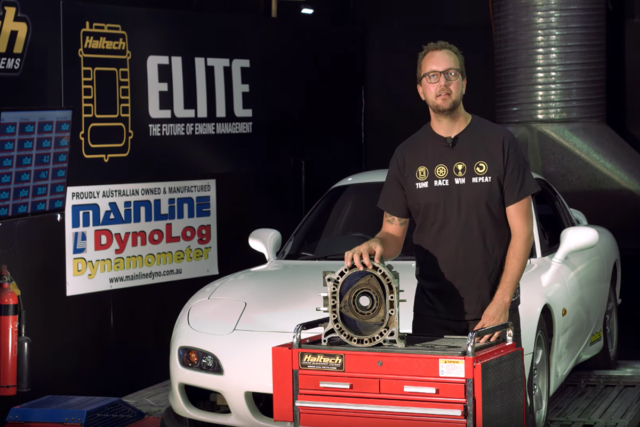Disclaimer: The topics covered in the article are generalized. It is not intended to be used as a copy and paste tuning guide, but rather as a reference to help our readers better understand how a rotary engine operates and what is required when tuning. Every engine is different, using the values referenced in this article without proper data logging and sufficient tuning knowledge may lead to engine damage.
If you do not understand the basics of how a rotary engine works, you may want to start with this article. Otherwise, continue reading.
Despite some of the rotary engine’s drawbacks such as having a low thermal efficiency, poor emissions and burning oil by design, it has still found its niche and is respected for being competitive in various types of racing. In the motorsports world, the rotary engine has seen some serious power. With some boosted rotary Mazda’s making over 700 horsepower at the wheels, a skilled tuner with a deep understanding of the rotary engine design is required.
 A rotary engine cannot be tuned using the same techniques as a piston engine. Using a 13B-REW out of an RX-7 for reference, Scott Hilzinger from the Australian aftermarket ECU manufacturer Haltech has posted a video to their YouTube channel covering the basic fueling and ignition requirements of a rotary engine.
A rotary engine cannot be tuned using the same techniques as a piston engine. Using a 13B-REW out of an RX-7 for reference, Scott Hilzinger from the Australian aftermarket ECU manufacturer Haltech has posted a video to their YouTube channel covering the basic fueling and ignition requirements of a rotary engine.
In most forms of motorsports, big power and high RPM is king. The rotary design cuts the amount of time available to inject the fuel and charge the ignition coil by half. For a rotary engine to make the same power as a piston engine, it requires a fuel system capable of delivering twice the amount of fuel and a more powerful ignition system.
A rotary engine would require 2,000 cc/min injectors to make the same power that a piston engine would on 1,000 cc/min injectors. Scott gives an example of a piston engine and a rotary engine both running at 6,000 RPM. The piston engine takes about 20 ms to complete a cycle compared to the rotary engine only taking 10 ms. If we raise the rev limit to 9,000 RPM, the rotary engine will only take 6.6 ms to complete an engine cycle.
Due to the irregular shape of the combustion chamber, a rotary engine uses two spark plugs. A leading spark plug, which is located lower in the housing and fires first to ignite the air/fuel mixture and a trailing spark that plug that fires 10 to 15 degrees after to help facilitate a uniform flame front across the face of the rotor.
Every engine will require a slightly different primary timing map. A good starting point for the ignition timing map is around 30 to 35 degrees in the cruise cells, 15 to 20 degrees at atmospheric pressure and if boosted, 10 degrees at peak boost. The split timing map controls the trailing spark plug and how many degrees after the leading spark it fires. Setting the split timing to about 10 degrees in the power cells will net the best gains with the lowest chance of causing any damage.
 When tuning the target fuel map, rotary engines like to run rich compared to a piston engine. A good starting point for a rotary engine fuel map at idle is between 13.5:1 and 14.1:1, low 11’s at atmospheric pressure and when under boost, quickly richening up to a flat 10.5:1 through redline. You will notice that a rotary engine will make similar power at an AFR of 10:1 as it would at 13:1.
When tuning the target fuel map, rotary engines like to run rich compared to a piston engine. A good starting point for a rotary engine fuel map at idle is between 13.5:1 and 14.1:1, low 11’s at atmospheric pressure and when under boost, quickly richening up to a flat 10.5:1 through redline. You will notice that a rotary engine will make similar power at an AFR of 10:1 as it would at 13:1.
The reason for using a target around 10.5:1 is to keep the combustion temperature under control and to properly lubricate the engine. The injection angle on a rotary engine tends to yield the best results around 330 degrees at redline and tapering to 270 degrees in the cruise and idle cells. On a build with properly matched components, it’s easy to tell if the injection angle is incorrect up top by looking at your horsepower curve. The curve should reach peak horsepower and stay close to this until redline; if it looks like the power curve rolls over and loses a noticeable amount of power near redline, your injection angle will need to be advanced or retarded, depending on the AFR.


















